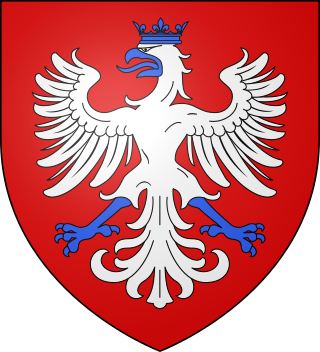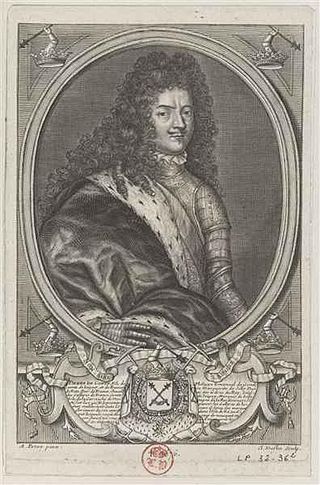
Seigneurs and Dukes of Retz owned the district of Retz or Rais, is in South Brittany.

Seigneurs and Dukes of Retz owned the district of Retz or Rais, is in South Brittany.
Rais belonged in early times to a house which bore its name, and of which the eldest branch became extinct in the 13th century in the Chabot family . [1]
From the Chabot family the lordship passed to the Lavals. Gilles de Laval, sire de Retz (c. 1405–1440), the comrade-in-arms of Joan of Arc and marshal of France, gave himself over to the most revolting debauchery, and was strangled and burned at Nantes. [1]
The barony of Retz passed successively to the families of Tournemine, Annebaut and Gondi. In 1581 it was erected into a duchy in the peerage of France (duché-pairie) for Albert de Gondi, marshal of France and general of the galleys . Pierre de Gondi, brother of the first duc de Retz, became bishop of Paris in 1570 and cardinal in 1587. He was succeeded by his nephews, Henri (died 1622) and Jean François de Gondi (died 1654), for whom the episcopal see of Paris was erected into an archbishopric in 1622, and by his great-nephew, Jean François Paul de Gondi, the famous cardinal de Retz. [1]
With the death of the last male of the house of Gondi in 1676 the duché-pairie became extinct; the lordship passed to the house of Neuville-Villeroy. [1]

The House of Bourbon is a dynasty that originated in the Kingdom of France and is a branch of the Capetian dynasty, the royal House of France. Bourbon kings first ruled France and Navarre in the 16th century, and by the 18th century, members of the Spanish Bourbon dynasty held thrones in Spain, Naples, Sicily, and Parma. Today Spain and Luxembourg have monarchs of the House of Bourbon. The royal Bourbons originated in 1272, when Robert, the youngest son of King Louis IX of France, married the heiress of the lordship of Bourbon. The house continued for three centuries as a cadet branch, serving as nobles under the direct Capetian and Valois kings.

Jean François Paul de Gondi, cardinal de Retz was a French churchman, writer of memoirs, and agitator in the Fronde.

The House of Montmorency was one of the oldest and most distinguished noble families in France.

The House of Rohan is a Breton family of viscounts, later dukes and princes in the French nobility, coming from the locality of Rohan in Brittany. Their line descends from the viscounts of Porhoët and is said to trace back to the legendary Conan Meriadoc. Through the Porhoët family, the Rohans are related to the Dukes of Brittany, with whom the family intermingled again after its inception. During the Middle Ages, it was one of the most powerful families in the Duchy of Brittany. The Rohans developed ties with the French and English royal houses as well, and they played an important role in French and European history.

The House of Baux is a French noble family from the south of France. It was one of the richest and most powerful families of Medieval Provence, known as the 'Race d’Aiglon'. They were independent Lords as castellans of Les Baux and Arles and wielded very considerable authority at local level. They held important fiefs and vast lands, including the principality of Orange.

Gilles de Rais, Baron de Rais, was a knight and lord from Brittany, Anjou and Poitou, a leader in the French army, and a companion-in-arms of Joan of Arc. He is best known for his reputation and later conviction as a confessed serial killer of children.
The Florentine banking family of the Gondi were prominent financial partners of the Medici. Unlike the Medici, they were of the old Florentine nobility, tracing their line traditionally from the legendary Philippi, said to have been ennobled by Charlemagne himself, in 805; from him the Strozzi and the Gualfreducci also claimed their descent. With Orlando Bellicozzo, a member of the Great Council of Florence in 1197, the Gondi emerge into history, receiving their patronymic from Gondo Gondi, sitting on the Great Council in 1251, signatory to a treaty between Florence and Genoa in that year. In the fourteenth century several members of the family sat on the Great Council. Simon de Gondi renounced the Ghibelline party for himself and his house, in 1351; he loaned the Republic 8000 golden florins in a time of extremity. He held extensive lands round Valcava, in the Mugello, where the church bore the Gondi arms inside and out. Of Simon's seven children, his grandson another Simon was the first of the Gondi to hold the position of Grand Prior of the Republic, on three occasions. His daughter Maddalena, who married Giovanni Salviati, by the marriage of her daughter Maria with Giovanni dalle Bande Nere, became the grandmother of Cosimo I de' Medici; thence were descended all the Catholic crowned heads of pre-Napoleonic Europe. Carlo de Gondi was a staunch backer of Piero de' Medici, and when the Medici came to be Grand Dukes, the Gondi received empty but honorary titles of Senators.

Montmirail is a commune in the Marne department in north-eastern France.

The House of Coligny was the name of an old and important French noble family, originating from the Bresse region of France. Their bloodline ended in 1694.
Prince Louis Jean Marie de La Trémoïlle, 11th Duke of Thouars was a French aristocrat. He was the 11th Duke of Thouars and 10th Duke of La Trémoïlle, 13th Prince of Tarente, 17th Prince of Talmond and 17th Count of Laval

Jean-François de Gondi was the first archbishop of Paris, from 1622 to 1654.

Claude Catherine de Clermont-Tonnerre de Vivonne, lady of Dampierre, countess and duchess of Retz, was a French courtier, writer and salon host.

Albert de Gondi, duc de Retz seigneur du Perron, comte, then marquis de Belle-Isle (1573), duc de Retz, was a marshal of France and a member of the Gondi family. Beginning his career during the Italian Wars he fought at the Battle of Renty in 1554, and in many of the campaigns into Italy in the following years, before returning to France for the disastrous battle of Saint-Quentin and battle of Gravelines both of which saw the French army savaged.

Henri de Gondi was a French bishop and cardinal of the Gondi family. He was the son of Albert de Gondi, duc de Retz and Claude Catherine de Clermont-Tonnerre. He succeeded his uncle Pierre de Gondi as bishop of Paris in 1598 and was succeeded on his death by his younger brother Jean-François de Gondi. He was made a cardinal in 1618.

Pierre de Gondi, cardinal de Retz (1533–1616) was a French bishop and cardinal of the Gondi family.
Duke of Richelieu was a title of French nobility. It was created on 26 November 1629 for Armand Jean du Plessis de Richelieu who, as a Catholic clergyman, had no issue to pass it down to. It instead passed to his great-nephew, Armand Jean de Vignerot, grandson of his elder sister Françoise du Plessis (1577–1615), who had married René de Vignerot, Seigneur de Pontcourlay.

Duke of Fronsac was a title of French nobility, first created by promoting the seigneurie of Fronsac to a duchy in 1608, but the title became extinct a few decades later. This title was revived in 1634 for Armand Jean du Plessis de Richelieu, better known as Cardinal Richelieu, and it survived until the 19th century.

Buzay Abbey, dedicated to Our Lady, was a Cistercian Abbey at Rouans in Pays de la Loire, France, formerly in Brittany, founded in 1135 and dissolved in 1790.